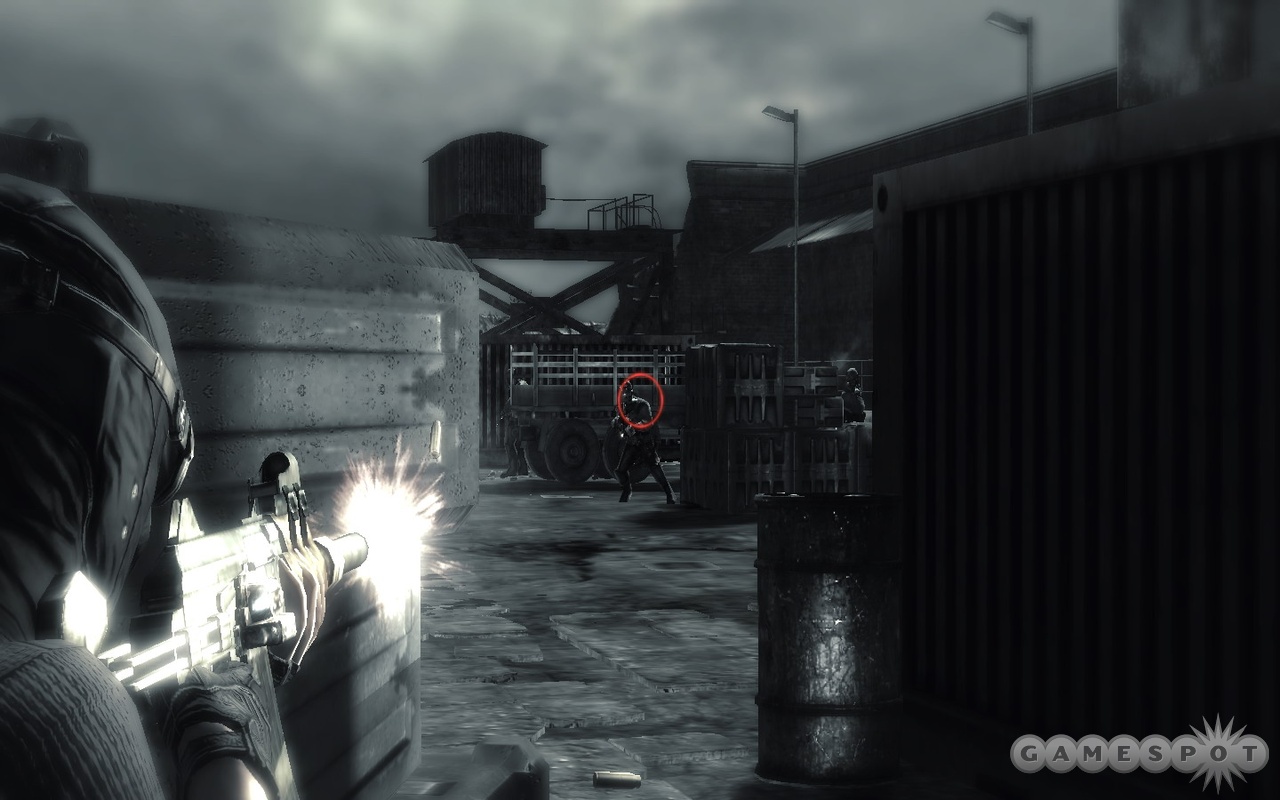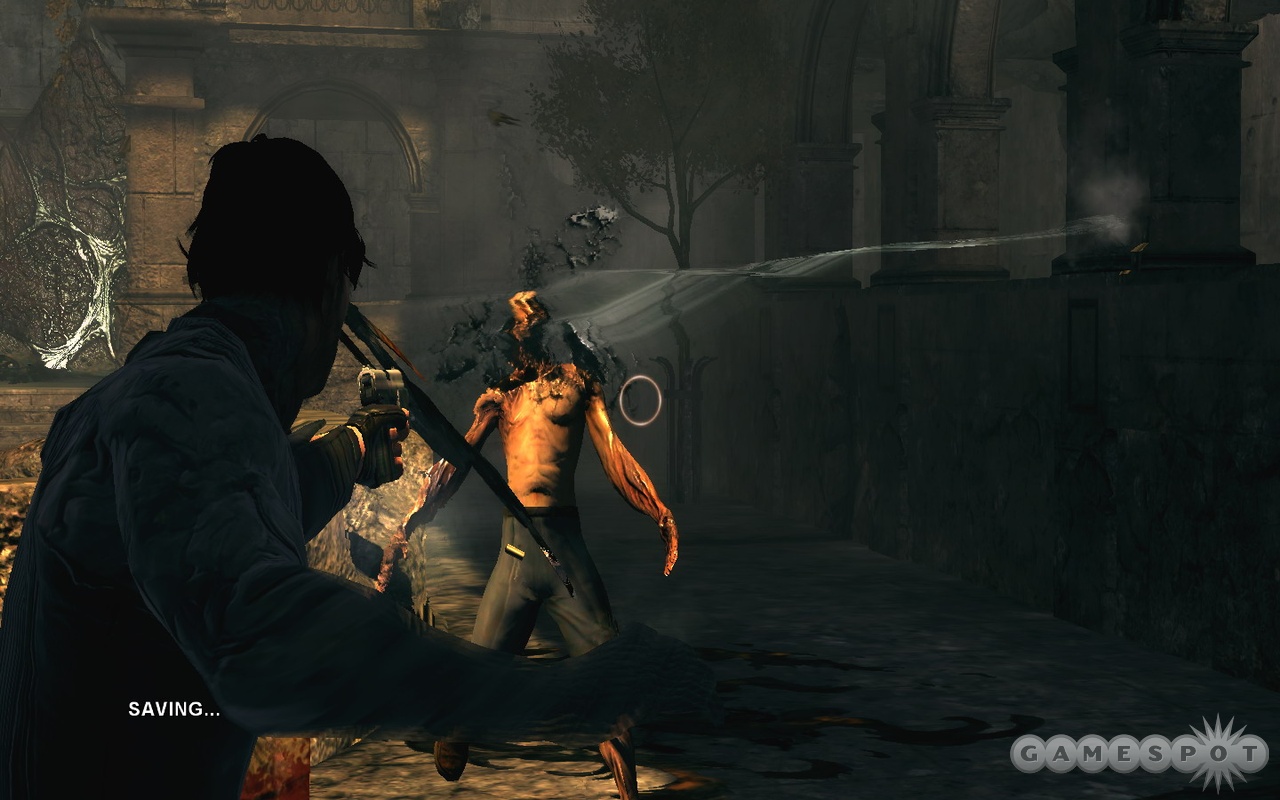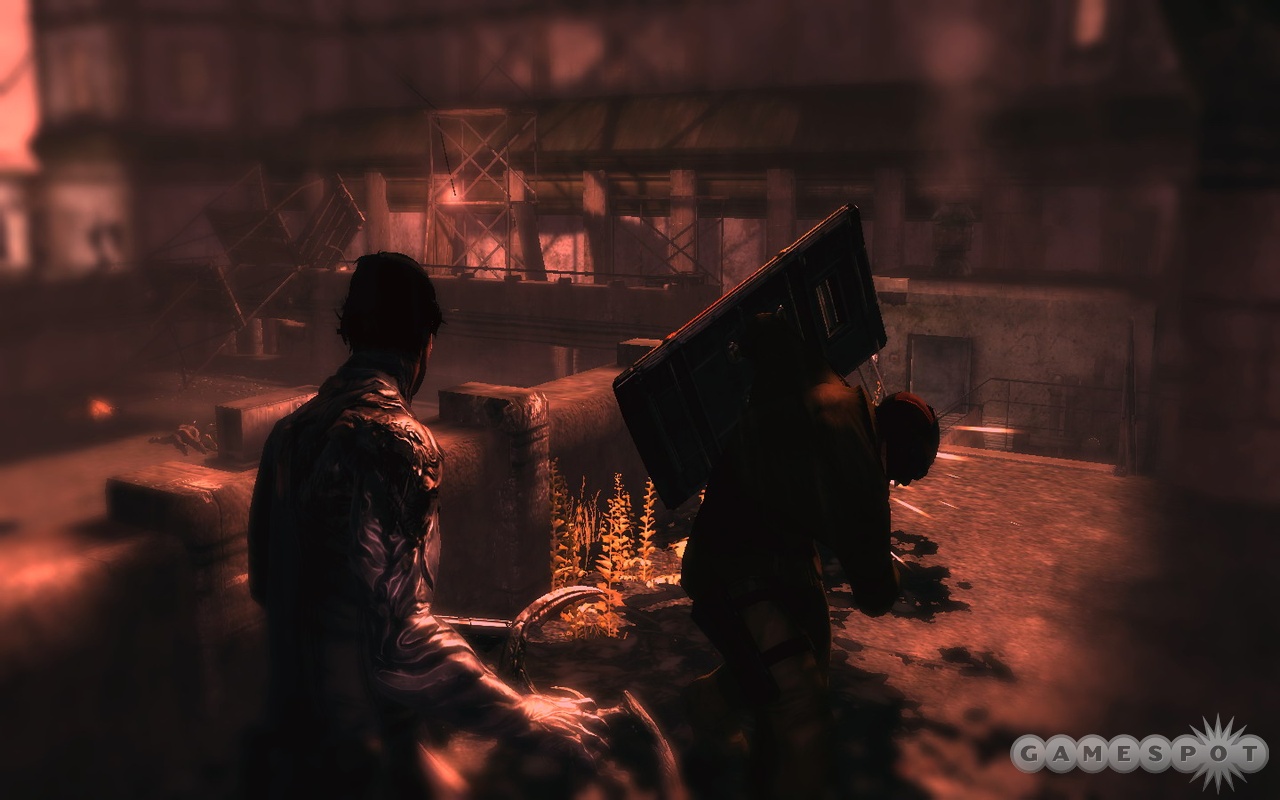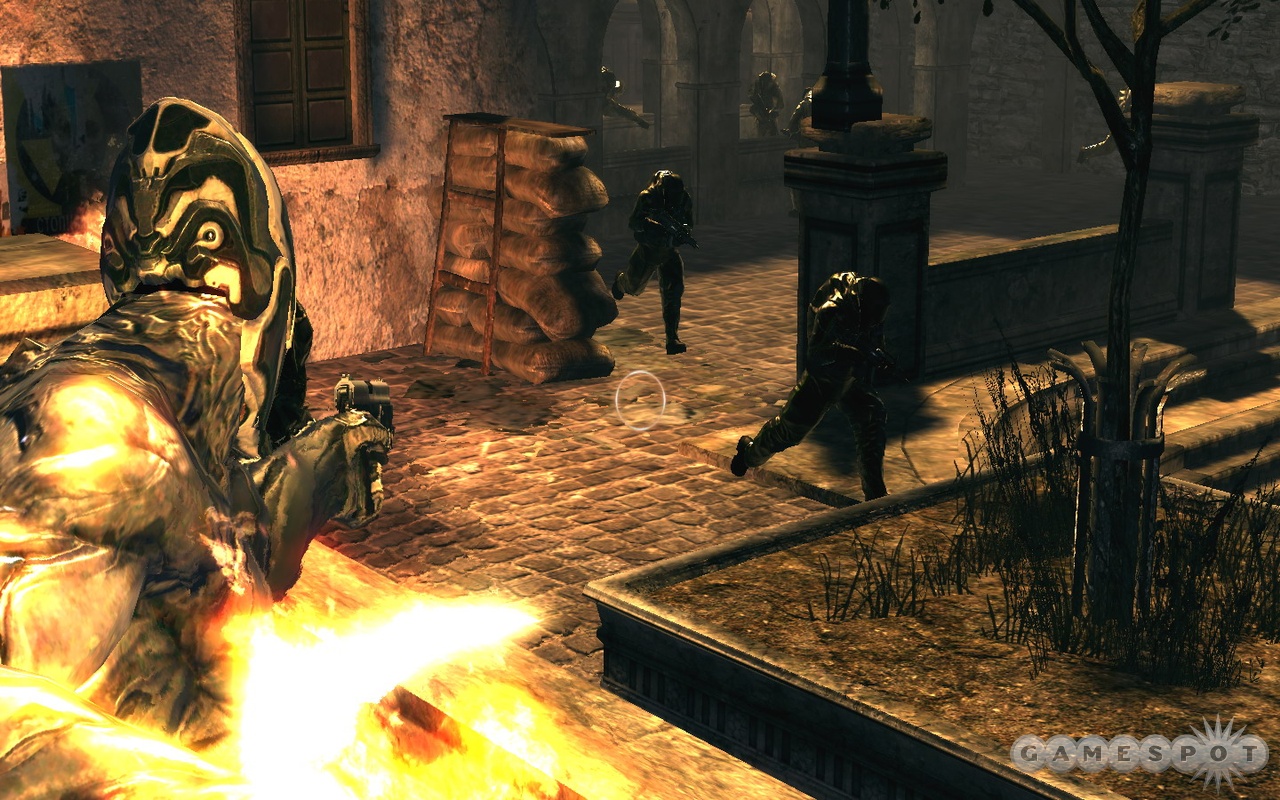Arriving on the PC a full year after it was released for the Xbox 360 and PlayStation 3, Dark Sector is a stylish action game in which you assume the role of Hayden Tenno, an elite black-ops agent with an infection that mutates his right hand into a lethal glaive. The boomerang-like glaive is an incredibly versatile weapon and, in conjunction with a decent selection of firearms, serviceable cover mechanics, and intelligent enemies, it keeps the single-player game entertaining from start to finish. The story is a mess, and sadly there's no online support for multiplayer in the PC version, but come here looking for 10 to 12 hours of satisfying combat and you won't be disappointed.

The single-player game starts off promisingly with a moody black-and-white prologue mission set some 20 years before the events of the other nine levels. Getting comfortable with the controls used for gunplay and for getting in and out of cover should take you no time at all, and it won't take you long to realize that the enemies you're facing are smart enough to employ a lot of the same tactics that you do in the interest of self-preservation. The story gets underway with a bang as well--a few bangs, actually--but as you progress through the game, the story rarely feels like it's moving along with you. Characters come and go without giving you any reason to care about them, you travel between locations killing everything that moves without really knowing why, and new abilities are frequently added to your formidable arsenal without explanation. Dark Sector's lack of good storytelling shouldn't hamper your enjoyment of the game too much because cutscenes are infrequent and brief. Nonetheless, it's unfortunate that a protagonist as fun to play as Hayden doesn't have a great narrative to back him up.
To simply refer to Hayden as a killing machine would be to downplay just how overpowered you can feel at times while playing as him. The skills with conventional firearms that you learn in the prologue mission stay with you for the entire game, but even as increasingly powerful weapons become available to you, you'll find that you spend far less time using them. That's because throwing the glaive that grows from his right hand early on is a more elegant, powerful, and satisfying way to dispatch foes than any gun. Initially, the glaive is used simply as a projectile weapon that comes back to you like a boomerang after every throw, making enemy decapitations and severed limbs a rare treat early on. However, when you gain the ability to add aftertouch to your throws, it becomes an even deadlier projectile that you can steer around corners and over obstacles to butcher enemies in glorious slow motion. Applying aftertouch not only makes slicing up enemies easier, but also affords you a front-row seat for the kill because you get to see everything from the glaive's perspective. Decapitating enemies this way never gets old, though some of the glaive's other uses definitely do.
The glaive isn't just an awesomely powerful weapon; it's a veritable Swiss Army knife that can be used to unlock doors, open ammo crates, and pick up items that would otherwise be out of reach. The uses for Dark Sector's answer to Link's boomerang don't end there, though, because with a little help from the elements your glaive can be used to light torches, create columns of ice, and even put out fires. By hitting specific items scattered throughout the world, it's possible to imbue your glaive with electricity, ice, or fire for a short time, at which point using it to kill enemies becomes more satisfying than ever. But that's rarely the reason why you're afforded access to an element; more often than not, the elements are needed to overcome environmental obstacles or to solve simplistic (though occasionally challenging, timed) puzzles. For example, sheets of black goop stretched across doorways have to be burned before you can progress, and mechanically sealed doors can be opened only with an electric charge. Puzzles like these crop up a little too frequently in Dark Sector and, given that you don't even have to think about them after the first occurrence, it doesn't take long for them to feel like chores that you have to complete before you're allowed to progress and have fun playing with enemies again.

Dark Sector's impressive combat sequences are also broken up with exploration, which becomes a necessary evil as you realize that searching every nook and cranny of an area before progressing to the next is the only way to find ammo, currency, and weapon upgrades. Money can be used to buy new weapons on the black market, which is conveniently located under every manhole you come across. It's important to buy and upgrade both a pistol (which you wield simultaneously with the glaive) and either a rifle or shotgun at some point, because weapons that you pick up from slain enemies function only for a short time before they're automatically disabled. There's a reason they do that, but going into it here would risk spoiling one of the story's very few twists for you. Weapons on the black market are extremely expensive, so despite the range of options to choose from, you shouldn't expect to own even half of them by the time you reach the boss at the end of your first play-through.
There are several boss battles in Dark Sector, and all of them are very different. Variety comes courtesy not only of bosses that differ wildly in shape and size, but also of the weapons and abilities that you'll need to defeat them. None of the bosses are overly challenging if you take your time with them because, with only a few exceptions, their attacks just aren't powerful enough to kill you with a single blow. They'll hurt you, and the borders of the screen will flash red to let you know that you're injured, but Hayden regains health so quickly that getting into cover briefly or even performing a few evasive rolls is generally all you need to do to get back to full strength. That's not to say that all of the boss battles are easy, though, because they're not. It's just that often the tricky part is figuring out how to beat them rather than actually doing it.

Although playing through Dark Sector's single-player mode doesn't reward you with a great story, it's definitely a great way to prepare for the game's LAN-only multiplayer offerings. There are only two multiplayer modes, but both of them will afford you the opportunity to play as Hayden at some point, complete with all of the skills that he has at the end of the single-player game. Both of the multiplayer games, titled Epidemic and Infection, were originally designed for only 10 players on consoles but now support up to 32 on five maps that are no longer big enough. Epidemic pits two teams, each led by a Hayden, against one another in a battle to see which team can kill the other's leader first. Infection challenges one player, as Hayden, to kill as many of the other players as possible before they manage to bring him down. When you're not playing as Hayden, you assume the role of a garden-variety soldier armed only with a firearm, explosives, and the ability to move in and out of cover. One Hayden versus everybody else might not sound like a fair fight, but when used in conjunction with shield and stealth abilities, Hayden's glaive-and-firearm combo gives him a significant edge over the competition. With that said, playing as Hayden is much more challenging now that there's the potential for so many more players to come after you.
Neither the game types nor the maps really lend themselves to groups of less than a dozen or so players, so it's really unfortunate that there's no online play. However, bots can be used to make up the numbers in the likely event that you have less than 32 players on your LAN. Like the enemies in the single-player game, the bots generally exhibit intelligent behavior but occasionally slip up. Regardless, Dark Sector's multiplayer modes are a lot of fun even when you're playing as a soldier, and the biggest disappointment is simply that there aren't more modes or maps. A straight-up deathmatch option in which everyone has Hayden's abilities would probably be chaotic, but this seems like a missed opportunity regardless, as does the vehicle that you commandeer for a time in the single-player game but which is nowhere to be found in multiplayer.

Dark Sector still manages to impress visually, though you'll occasionally stumble upon low-resolution textures while searching with a flashlight in darkened corners for pickups. Widescreen support is also less than perfect, considering that opting for any of the supported 16:10 or 16:9 resolutions crops off the top and bottom of the screen and slightly stretches what's left vertically. Furthermore, it's a little jarring in such a realistic-looking world that your glaive frequently travels through walls on its way back to you, but then this is a game that really tests your ability to suspend disbelief at every opportunity, given the nature of its puzzles and the lack of storyline. The game's audio is also worthy of note, thanks to an original score that does a great job of letting you know when danger is present or past. Likewise, some really satisfying sound effects make the weapons feel powerful, the environments feel creepy and abandoned, and some of the enemies far more intimidating than they deserve.
As much fun as Dark Sector is, this PC port isn't everything that it should have been. Bumping up the multiplayer count from 10 to 32 is all well and good, but the modes and the maps aren't designed with that many players in mind, and the lack of online is unforgivable. The PC version of Dark Sector should have been an opportunity for the underappreciated multiplayer modes from the console games to finally find an audience, but as it stands this is an inferior game that's fun only for as long as it takes you to reach and defeat the final boss in the single-player mode.